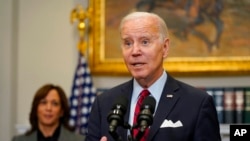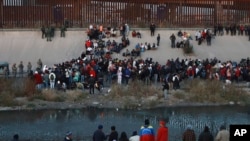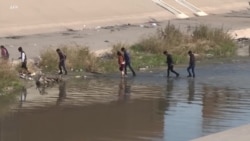U.S. President Joe Biden announced Thursday measures to crack down on migrants seeking to enter the United States without authorization from Mexico while offering a new pathway to legal entry for up to 30,000 people a month from Venezuela, Nicaragua, Cuba and Haiti.
The measures will make it easier for border authorities to quickly expel migrants who enter the U.S. between legal crossing points and revive country agreements where would-be asylum-seekers, who passed through a third country, must show they failed to receive protections there before asking for asylum at the U.S.-Mexico border.
However, individuals in the four named countries will be allowed to apply for legal entry to the United States from abroad under the humanitarian parole authority now being used to admit some refugees from Afghanistan and Ukraine.
Biden officials touted the plan as a pathway to legally allow migrants to travel to the U.S. in an orderly, safe manner. But immigration advocates countered that the policies inappropriately limited asylum protections guaranteed under U.S. and international law.
During a news conference at the White House, Biden said the humanitarian parole measure would allow migrants from Nicaragua, Cuba and Haiti who have U.S.-based financial sponsors to legally enter the country through a program modeled on the Ukraine program and an earlier Venezuelan program. Those programs allow migrants to travel by air to the U.S. if they have sponsors and pass background checks.
“These actions alone that I’m announcing today aren’t going to fix our immigration system, but they can help us a good deal. … I can only act where I have the legal capacity to do so,” Biden said.
The humanitarian parole authority allows the approved applicants to live and work legally in the U.S. temporarily.
In response to the announcement, Krish O’Mara Vignarajah, president and CEO of Lutheran Immigration and Refugee Service, said in a statement that humanitarian parole cannot be a replacement for asylum protections.
“It will provide only temporary protection to a small subset of the millions of people forced to flee their homes. Far more concerning is the expansion of Title 42 expulsions that will now apply to more people seeking to exercise their legal right to seek asylum,” she said.
Title 42 is a public health policy that allows for the immediate expulsion of migrants during public health emergencies. But there were exceptions that allowed migrants from Venezuela, Nicaragua, Cuba and Haiti to be processed into the U.S. Under the new plan, if they arrive at the southwestern border, they will instead be returned to Mexico.
The use of the health order, which immigration advocates say is no longer needed, created a backlog in Mexico of migrants seeking asylum in the U.S.
In various reports, U.S. border officials and immigration advocates say the larger numbers of migrants at the border reflect the deteriorating economic and political conditions in some countries that drive people to come to the southwestern border of the U.S.
Other Biden officials also briefed reporters Thursday, on the condition that their names not be used as is common in White House briefings, saying the humanitarian pathway will keep migrants from making the dangerous journey to the U.S. border.
However, the plan has a limit of 30,000 total admissions each month.
“Currently, these four countries accounted for most of the people traveling into Mexico to start a new life by getting to the American border and trying to cross,” Biden said.
The new initiative includes efforts to discourage unlawful entries along the southwestern border.
U.S. Homeland Security Secretary Alejandro Mayorkas said in a news conference with reporters that “effective immediately” migrants would be “swiftly sent back to Mexico.”
“The border is not open,” Mayorkas said, adding that border officials would increase the use of expedited removal.
A migrant is fast-tracked for removal if a U.S. immigration officer concludes the person does not have a valid asylum claim, a determination made without the migrant appearing before an immigration judge. Unaccompanied children who cross the border into the United States are exempted from the policy.
Mexico has agreed to accept up to 30,000 migrants a month who do not qualify for the humanitarian program.
How program will work
According to Biden officials, a migrant requesting humanitarian parole will have to file an applications with Customs and Border Protection through the CBP One app, submit proof of an eligible sponsor and and pass a background check to receive authorization to travel to the United States.
For two years, the beneficiaries of the parole program will have legal status and be allowed to legally work in the U.S.
Biden and Mayorkas made a point to say that after Thursday’s announcement, individuals who cross Panama and Mexico to get to the U.S. border and cross without authorization will not be eligible for the parole process and will be subject to immediate expulsion.
At Thursday’s news conference, Mayorkas said there would be discretion but did not elaborate on what exceptions — still to be written — might be granted.
Mayorkas said migrants who “circumvent available established pathways to lawful migration and also failed to seek protection in a country to which they traveled on their way to the United States” would be ineligible for asylum in the United States.
“Unless they meet exceptions that will be specified, individuals who cannot establish a valid claim to protection under the standard set out in the new rule will be subject to prompt removal under Title 8 authorities, which carries a five-year ban on re-entry,” he said.
Reaction
Jonathan Blazer, director of border strategies at the American Civil Liberties Union, said in a statement that Biden recognized that seeking asylum is a legal right, but the plan continues to tie the current administration to anti-immigrant policies instead of restoring access to asylum protections.
“President Biden explicitly condemned [former President Donald] Trump’s asylum ban against people who travel through other countries and made a campaign promise to end it and restore our asylum laws. But today the White House announced that he plans to bring a version of that ban back,” Blazer added.
Other immigration advocates criticized the sponsorship requirement for those seeking asylum.
Austin Kocher, an assistant professor and researcher with the Transactional Records Access Clearinghouse at Syracuse University, told VOA the Biden administration is understandably under pressure to create a sense of control at the border.
“But adding conditions and barriers to the asylum process that are not part of U.S. and international law contradicts Biden’s claims that he would be different than his predecessor,” he said.
Mayorkas and other immigration officials rebutted that claim.
“This has no resemblance to the transit ban that was imposed in the Trump administration because we have built lawful pathways. We do have a way for asylum-seekers to seek relief at the ports of entry. We will, of course, have exceptions for humanitarian reasons when individuals cannot avail themselves of the CBP One application. So, this is quite, quite different,” Mayorkas said.
Biden is scheduled to travel to El Paso, Texas, this weekend. It will be his first trip to the southwestern border as president. He said he waited to see what was going to happen to Title 42, which is tied up in a case before the U.S. Supreme Court, before he decided to visit the border.
“I wanted to make sure that I knew what the outcome or at least the near outcome was on Title 42 before I went down [to the border]. We don't have that yet. So I had to operate. I don't like Title 42, but it's the law now and we have to operate within it,” Biden said.
The president is traveling to Mexico City to meet with North American leaders on Monday after his El Paso visit.









